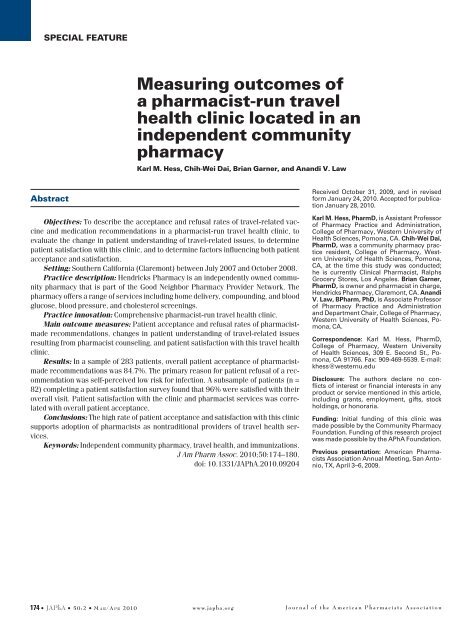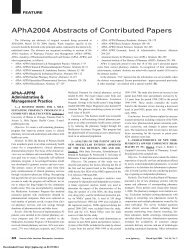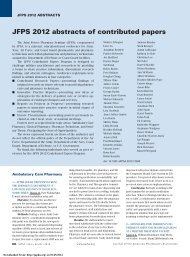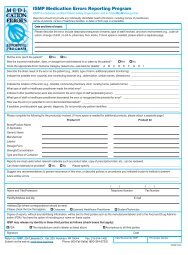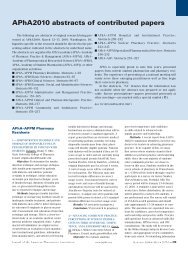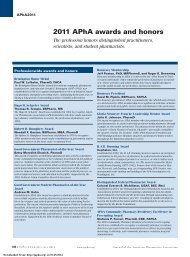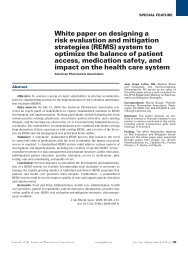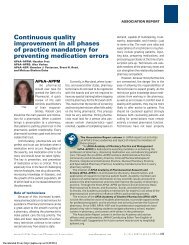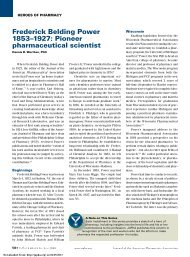Measuring outcomes of a pharmacist-run travel health clinic located ...
Measuring outcomes of a pharmacist-run travel health clinic located ...
Measuring outcomes of a pharmacist-run travel health clinic located ...
You also want an ePaper? Increase the reach of your titles
YUMPU automatically turns print PDFs into web optimized ePapers that Google loves.
SPECIAL FEATURE<br />
Abstract<br />
Objectives: To describe the acceptance and refusal rates <strong>of</strong> <strong>travel</strong>-related vaccine<br />
and medication recommendations in a <strong>pharmacist</strong>-<strong>run</strong> <strong>travel</strong> <strong>health</strong> <strong>clinic</strong>, to<br />
evaluate the change in patient understanding <strong>of</strong> <strong>travel</strong>-related issues, to determine<br />
patient satisfaction with this <strong>clinic</strong>, and to determine factors influencing both patient<br />
acceptance and satisfaction.<br />
Setting: Southern California (Claremont) between July 2007 and October 2008.<br />
Practice description: Hendricks Pharmacy is an independently owned community<br />
pharmacy that is part <strong>of</strong> the Good Neighbor Pharmacy Provider Network. The<br />
pharmacy <strong>of</strong>fers a range <strong>of</strong> services including home delivery, compounding, and blood<br />
glucose, blood pressure, and cholesterol screenings.<br />
Practice innovation: Comprehensive <strong>pharmacist</strong>-<strong>run</strong> <strong>travel</strong> <strong>health</strong> <strong>clinic</strong>.<br />
Main outcome measures: Patient acceptance and refusal rates <strong>of</strong> <strong>pharmacist</strong>made<br />
recommendations, changes in patient understanding <strong>of</strong> <strong>travel</strong>-related issues<br />
resulting from <strong>pharmacist</strong> counseling, and patient satisfaction with this <strong>travel</strong> <strong>health</strong><br />
<strong>clinic</strong>.<br />
Results: In a sample <strong>of</strong> 283 patients, overall patient acceptance <strong>of</strong> <strong>pharmacist</strong>made<br />
recommendations was 84.7%. The primary reason for patient refusal <strong>of</strong> a recommendation<br />
was self-perceived low risk for infection. A subsample <strong>of</strong> patients (n =<br />
82) completing a patient satisfaction survey found that 96% were satisfied with their<br />
overall visit. Patient satisfaction with the <strong>clinic</strong> and <strong>pharmacist</strong> services was correlated<br />
with overall patient acceptance.<br />
Conclusions: The high rate <strong>of</strong> patient acceptance and satisfaction with this <strong>clinic</strong><br />
supports adoption <strong>of</strong> <strong>pharmacist</strong>s as nontraditional providers <strong>of</strong> <strong>travel</strong> <strong>health</strong> services.<br />
Keywords: Independent community pharmacy, <strong>travel</strong> <strong>health</strong>, and immunizations.<br />
J Am Pharm Assoc. 2010;50:174–180.<br />
doi: 10.1331/JAPhA.2010.09204<br />
174 • JAPhA • 50:2 • M a r/apr 2010<br />
<strong>Measuring</strong> <strong>outcomes</strong> <strong>of</strong><br />
a <strong>pharmacist</strong>-<strong>run</strong> <strong>travel</strong><br />
<strong>health</strong> <strong>clinic</strong> <strong>located</strong> in an<br />
independent community<br />
pharmacy<br />
Karl M. Hess, Chih-Wei Dai, Brian Garner, and Anandi V. Law<br />
www.japha.org<br />
Received October 31, 2009, and in revised<br />
form January 24, 2010. Accepted for publication<br />
January 28, 2010.<br />
Karl M. Hess, PharmD, is Assistant Pr<strong>of</strong>essor<br />
<strong>of</strong> Pharmacy Practice and Administration,<br />
College <strong>of</strong> Pharmacy, Western University <strong>of</strong><br />
Health Sciences, Pomona, CA. Chih-Wei Dai,<br />
PharmD, was a community pharmacy practice<br />
resident, College <strong>of</strong> Pharmacy, Western<br />
University <strong>of</strong> Health Sciences, Pomona,<br />
CA, at the time this study was conducted;<br />
he is currently Clinical Pharmacist, Ralphs<br />
Grocery Stores, Los Angeles. Brian Garner,<br />
PharmD, is owner and <strong>pharmacist</strong> in charge,<br />
Hendricks Pharmacy, Claremont, CA. Anandi<br />
V. Law, BPharm, PhD, is Associate Pr<strong>of</strong>essor<br />
<strong>of</strong> Pharmacy Practice and Administration<br />
and Department Chair, College <strong>of</strong> Pharmacy,<br />
Western University <strong>of</strong> Health Sciences, Pomona,<br />
CA.<br />
Correspondence: Karl M. Hess, PharmD,<br />
College <strong>of</strong> Pharmacy, Western University<br />
<strong>of</strong> Health Sciences, 309 E. Second St., Pomona,<br />
CA 91766. Fax: 909-469-5539. E-mail:<br />
khess@westernu.edu<br />
Disclosure: The authors declare no conflicts<br />
<strong>of</strong> interest or financial interests in any<br />
product or service mentioned in this article,<br />
including grants, employment, gifts, stock<br />
holdings, or honoraria.<br />
Funding: Initial funding <strong>of</strong> this <strong>clinic</strong> was<br />
made possible by the Community Pharmacy<br />
Foundation. Funding <strong>of</strong> this research project<br />
was made possible by the APhA Foundation.<br />
Previous presentation: American Pharmacists<br />
Association Annual Meeting, San Antonio,<br />
TX, April 3–6, 2009.<br />
J o u r n a l o f t h e A m e r i c a n P h a r m a c i s t s A s s o c i a t i o n<br />
174 3/1/10 12:49 PM
From 1999 to 2009, approximately 290 million visits<br />
were made by U.S. citizens to overseas international<br />
destinations such as the European Union, the Caribbean,<br />
Asia, Central and South America, Oceania, the Middle<br />
East, and Africa. 1 The World Health Organization recommends<br />
that <strong>travel</strong>ers “consult a <strong>travel</strong> medicine practitioner or physician<br />
four to eight weeks before departure in order to allow<br />
sufficient time for optimal immunization schedules to be completed.”<br />
2 Despite this recommendation, many <strong>travel</strong>ers do not<br />
seek the advice <strong>of</strong> their physician or other <strong>health</strong> care provider<br />
to learn about and protect themselves from otherwise preventable<br />
food-, water-, and vector-borne diseases before departure<br />
from the United States. Furthermore, approximately 22% to<br />
64% <strong>of</strong> American <strong>travel</strong>ers report some <strong>health</strong> problem that<br />
might have otherwise been prevented during <strong>travel</strong> (e.g., diarrhea,<br />
respiratory infections, dermatological conditions);<br />
however, less than 10% actually seek medical attention while<br />
<strong>travel</strong>ing. 3<br />
A survey conducted in 2004 indicated that only 36% <strong>of</strong><br />
<strong>travel</strong>ers sought <strong>travel</strong> <strong>health</strong> advice before departing the<br />
United States. Among individuals who did not seek advice, 22%<br />
did not perceive a need to do so, 20% did not perceive a risk<br />
At a Glance<br />
Synopsis: The current work describes the experiences<br />
<strong>of</strong> a <strong>pharmacist</strong>-<strong>run</strong> <strong>travel</strong> <strong>health</strong> <strong>clinic</strong> at an<br />
independent community pharmacy in southern California.<br />
Insight is provided into patient acceptance <strong>of</strong> <strong>pharmacist</strong>-made<br />
recommendations, reasons for refusal <strong>of</strong><br />
recommendations, effect on self-reported understanding<br />
<strong>of</strong> <strong>travel</strong>-related issues, and satisfaction with the<br />
<strong>clinic</strong>. Among 283 patients, overall acceptance <strong>of</strong> <strong>pharmacist</strong>-made<br />
recommendations was 84.7%. The primary<br />
reason for patient refusal <strong>of</strong> a recommendation<br />
was self-perceived low risk for infection. A satisfaction<br />
survey among 82 patients found that 96% were satisfied<br />
with their overall visit. Patient satisfaction with<br />
the <strong>clinic</strong> and <strong>pharmacist</strong> services was correlated with<br />
overall patient acceptance.<br />
Analysis: The authors believe that this <strong>travel</strong><br />
<strong>health</strong> service can be reproduced within other independent<br />
community pharmacies, especially when a strong<br />
collaboration exists among the <strong>travel</strong> <strong>clinic</strong> <strong>pharmacist</strong>,<br />
pharmacy store owner, and supervising physician.<br />
The highest rate <strong>of</strong> patient acceptance was for the yellow<br />
fever vaccine (96.8%), probably because the majority<br />
<strong>of</strong> patients in this <strong>clinic</strong> were <strong>travel</strong>ing to yellow<br />
fever endemic areas within South America and Africa,<br />
for which yellow fever vaccination normally would be<br />
indicated and recommended. For independent community<br />
pharmacies to more broadly implement similar<br />
<strong>travel</strong> <strong>health</strong> <strong>clinic</strong>s, further study <strong>of</strong> the costs associated<br />
with starting up and maintaining such <strong>clinic</strong>s as<br />
well as their pr<strong>of</strong>itability is necessary.<br />
PHARMACIST-RUn TRAvEL HEALTH CLInIC SPECIAL FEATURE<br />
<strong>of</strong> illness at their <strong>travel</strong> destination, and 10% were too busy to<br />
either make an appointment or keep their scheduled appointment.<br />
4 The results <strong>of</strong> this survey indicate that few Americans<br />
are aware <strong>of</strong> the medical issues that surround international<br />
<strong>travel</strong> and the need for protection against bothersome (e.g.,<br />
<strong>travel</strong>ers’ diarrhea, cutaneous larva migrans) and potentially<br />
fatal (e.g., yellow fever, malaria, rabies) <strong>travel</strong>-related diseases.<br />
Community <strong>pharmacist</strong>s can play a vital role in patient education<br />
and disease prevention because <strong>of</strong> their high visibility<br />
and accessibility to the general public in local communities. In<br />
most states, collaborative practice laws exist that allow <strong>pharmacist</strong>s<br />
to administer routine and <strong>travel</strong>-related vaccines and/<br />
or to furnish medications to their patients under a physiciansupervised<br />
collaborative practice protocol. As a result, community<br />
pharmacies can <strong>of</strong>fer a unique experience whereby<br />
patients can receive all necessary vaccines, oral medications,<br />
and other <strong>travel</strong> supplies, as well as in-depth patient education<br />
regarding their <strong>travel</strong> plans, in one <strong>clinic</strong> appointment. Properly<br />
marketed and advertised, community pharmacy–based <strong>travel</strong><br />
<strong>health</strong> <strong>clinic</strong>s may help to increase the overall percentage<br />
<strong>of</strong> individuals seeking <strong>travel</strong> <strong>health</strong> advice and may help to increase<br />
public awareness <strong>of</strong> the multitude <strong>of</strong> diseases that can<br />
occur during <strong>travel</strong> and the importance <strong>of</strong> preventing them.<br />
Hendricks Pharmacy is an independently owned community<br />
pharmacy that is part <strong>of</strong> the Good Neighbor Pharmacy Provider<br />
Network. It is <strong>located</strong> in and has been serving the needs<br />
<strong>of</strong> the greater Claremont, CA, area for more than 50 years. The<br />
clientele <strong>of</strong> the pharmacy consists largely <strong>of</strong> college students<br />
and retirees who use the pharmacy not only for its traditional<br />
dispensing, home delivery, and compounding services but also<br />
for receiving routine immunizations such as influenza, hepatitis<br />
B, and tetanus booster. In addition, the pharmacy <strong>of</strong>fers<br />
screenings and patient education for common diseases such<br />
as diabetes, hypertension, and dyslipidemia. In July 2007,<br />
Hendricks Pharmacy established an international <strong>travel</strong> <strong>health</strong><br />
<strong>clinic</strong> that follows a <strong>pharmacist</strong>–physician collaborative practice<br />
protocol. The <strong>clinic</strong> is <strong>located</strong> in a completely private area<br />
within the pharmacy and has all necessary supplies and equipment<br />
(e.g., syringes, sharps containers, biohazard waste containers,<br />
separate refrigerator/freezer with vaccines, computer<br />
with Internet access) contained in it to help facilitate patient<br />
care activities. Further, the <strong>clinic</strong> is adjacent to and has direct<br />
access to the main pharmacy and dispensing areas to help facilitate<br />
workflow between locations. This <strong>clinic</strong> usually cares<br />
for patients within a radius <strong>of</strong> 15 miles from the pharmacy,<br />
as the <strong>clinic</strong> is the only one <strong>of</strong> its kind in the immediate area;<br />
however, patients have come from as far away as 100 miles for<br />
care in isolated cases. After the <strong>pharmacist</strong>’s consultation in<br />
the <strong>travel</strong> <strong>health</strong> <strong>clinic</strong>, the patient’s insurance plan is billed<br />
for services rendered; however, most patients pay out <strong>of</strong> pocket<br />
because <strong>travel</strong>-related vaccines and medications are not<br />
generally covered by insurance. The international <strong>travel</strong> <strong>health</strong><br />
<strong>clinic</strong> has been made visible in large part because <strong>of</strong> extensive<br />
marketing and promotion through in-store flyers and posters,<br />
mailed advertisements and letters, and physician detailing.<br />
J o u r n a l o f t h e A m e r i c a n P h a r m a c i s t s A s s o c i a t i o n www.japha.org M a r/apr 2010 • 50:2 • JAPhA • 175<br />
175 3/1/10 12:49 PM
SPECIAL FEATURE PHARMACIST-RUn TRAvEL HEALTH CLInIC<br />
The <strong>pharmacist</strong>–physician collaborative practice protocol<br />
under which the <strong>clinic</strong> operates allows the <strong>pharmacist</strong>s, community<br />
pharmacy residents, and student <strong>pharmacist</strong>s at Hendricks<br />
Pharmacy to administer all necessary vaccines and to<br />
furnish appropriate <strong>travel</strong>-related medications to patients before<br />
their departure. In addition, the <strong>clinic</strong> is recognized as an<br />
<strong>of</strong>ficial yellow fever vaccination center by the Centers for Disease<br />
Control and Prevention. The <strong>clinic</strong>’s director (K.M. Hess)<br />
completed a community pharmacy practice residency focused<br />
largely on <strong>travel</strong> <strong>health</strong> and is currently a full-time pharmacy<br />
practice faculty member who teaches in the area <strong>of</strong> immunizations<br />
and <strong>travel</strong> <strong>health</strong>. He also holds the Certificate in Travel<br />
Health (CTH) from the International Society <strong>of</strong> Travel Medicine<br />
(ISTM). According to ISTM, the CTH “recognizes individual excellence<br />
in knowledge in the field <strong>of</strong> <strong>travel</strong> medicine, associated<br />
with pre-<strong>travel</strong> care and consultation.” 5 The <strong>clinic</strong> is staffed<br />
with one to two <strong>pharmacist</strong>s, two to three student <strong>pharmacist</strong>s,<br />
and a community pharmacy practice resident; however,<br />
most consultations are done by K.M. Hess. The goals <strong>of</strong> this<br />
<strong>clinic</strong> are to help improve patient <strong>health</strong> status by educating<br />
patients about <strong>health</strong> and personal risks such as malaria, <strong>travel</strong>ers’<br />
diarrhea, and other non–vaccine-preventable diseases,<br />
as well as advising them on good <strong>health</strong> practices to prevent<br />
food-, water-, and vector-borne diseases while <strong>travel</strong>ing.<br />
During the study period (July 2007 to October 2008), 283<br />
patients were seen at this <strong>pharmacist</strong>-<strong>run</strong> <strong>travel</strong> <strong>health</strong> <strong>clinic</strong><br />
for advice and recommendations regarding a variety <strong>of</strong> destinations<br />
ranging from Western Europe to Sub-Saharan Africa.<br />
The majority <strong>of</strong> the patients’ <strong>travel</strong> destinations were <strong>located</strong><br />
within South America or Africa, where a need may have existed<br />
for vaccinating them against yellow fever. During this time period,<br />
more than 700 <strong>travel</strong>-related vaccines and medications<br />
were either administered or dispensed according to the <strong>clinic</strong>’s<br />
collaborative practice protocol.<br />
Few reports appear in the literature regarding <strong>pharmacist</strong>-<strong>run</strong><br />
<strong>travel</strong> <strong>health</strong> <strong>clinic</strong>s in the United States. Two previous<br />
studies described a <strong>pharmacist</strong>-<strong>run</strong> telepharmacy-based <strong>travel</strong><br />
<strong>clinic</strong> service that predominately serves members <strong>of</strong> a large<br />
<strong>health</strong> maintenance organization. 6,7 Another study described<br />
the implementation <strong>of</strong> a pre<strong>travel</strong> <strong>health</strong> program within a local<br />
supermarket chain. 8 To our knowledge, no published study<br />
has evaluated patient <strong>outcomes</strong> and satisfaction associated<br />
with a <strong>pharmacist</strong>-<strong>run</strong> <strong>travel</strong> <strong>health</strong> <strong>clinic</strong> within the independent<br />
community pharmacy setting. Patient satisfaction with<br />
<strong>travel</strong>-related services provided by a primary care provider<br />
was evaluated in another study, which found that satisfaction<br />
was associated with receiving care in one location; however,<br />
no objective measurement <strong>of</strong> satisfaction was included. 9<br />
Objectives<br />
We sought to examine the effectiveness <strong>of</strong> a <strong>pharmacist</strong>-<strong>run</strong><br />
<strong>travel</strong> <strong>health</strong> <strong>clinic</strong> by analyzing patient acceptance and refusal<br />
rates to <strong>pharmacist</strong>-made recommendations, changes<br />
in patient understanding <strong>of</strong> <strong>travel</strong>-related issues, and patient<br />
satisfaction with this <strong>travel</strong> <strong>health</strong> <strong>clinic</strong>. Finally, we aimed to<br />
explore factors influencing these <strong>outcomes</strong>.<br />
176 • JAPhA • 50:2 • M a r/apr 2010<br />
www.japha.org<br />
Methods<br />
This study consisted <strong>of</strong> both a retrospective review <strong>of</strong> all patient<br />
records and a prospective survey <strong>of</strong> all patients who made<br />
appointments in the <strong>travel</strong> <strong>health</strong> <strong>clinic</strong> during the study period<br />
(from July 31, 2007, to October 31, 2008; n = 283). Institutional<br />
review board approval was obtained from the primary<br />
author’s institution.<br />
A retrospective review <strong>of</strong> patient records was conducted<br />
by analyzing all <strong>pharmacist</strong>-made recommendations that were<br />
logged into the <strong>clinic</strong>’s database, which is continually updated<br />
after each patient visit. This database contains information on<br />
each patient, including their age, gender, destination <strong>of</strong> <strong>travel</strong>,<br />
and all recommendations made by the <strong>pharmacist</strong> and acceptance<br />
or refusal <strong>of</strong> these recommendations by patients. All<br />
<strong>pharmacist</strong>-made recommendations were derived from a systematic<br />
evidence-based review <strong>of</strong> well-established, commonly<br />
used, and frequently updated Internet-based <strong>travel</strong> medicine<br />
programs (e.g., Travax, Tropimed, TravelCare) and from each<br />
patient’s specific <strong>travel</strong> itinerary obtained from their <strong>travel</strong> history<br />
form, which was submitted to the <strong>clinic</strong> before their scheduled<br />
visit. Patients obtained this <strong>travel</strong> history form by downloading<br />
it from the pharmacy’s website (www.hendrickspharmacy.com).<br />
Descriptive analysis <strong>of</strong> the retrospective data from<br />
patients seen at the <strong>travel</strong> <strong>clinic</strong> was conducted to determine<br />
the rate <strong>of</strong> acceptance <strong>of</strong> <strong>pharmacist</strong>-made recommendations<br />
per vaccination type and overall across all vaccinations. Acceptance<br />
was calculated as the ratio <strong>of</strong> number <strong>of</strong> administered<br />
vaccines to vaccines recommended by the <strong>pharmacist</strong>.<br />
Correlational analyses were conducted to test the likelihood<br />
that acceptance <strong>of</strong> one type <strong>of</strong> <strong>travel</strong> vaccine was related to acceptance<br />
<strong>of</strong> others.<br />
In addition, an exploratory survey was developed to help<br />
evaluate patient satisfaction with the services provided by<br />
the <strong>clinic</strong>, possible reasons for refusal <strong>of</strong> any recommendation<br />
made, and patient understanding <strong>of</strong> <strong>travel</strong>-related issues.<br />
Multiple-choice questions on a four-point Likert-type scale (1,<br />
strongly disagree; 2, disagree; 3, agree; 4, strongly agree) were<br />
used to determine patient understanding <strong>of</strong> <strong>travel</strong>-related issues<br />
and patient satisfaction with the <strong>travel</strong> <strong>health</strong> <strong>clinic</strong>. Openended<br />
questions were used to determine patient perceptions<br />
<strong>of</strong> the <strong>travel</strong> <strong>health</strong> <strong>clinic</strong>. The survey was reviewed by a panel<br />
for face and content validity and was initially administered by<br />
the investigators via phone from a private <strong>of</strong>fice during normal<br />
business hours between 9:00 am and 5:00 pm. Three separate<br />
attempts were made to reach patients by phone during this survey<br />
stage, which lasted for approximately 2 months. Patients<br />
who could not be reached by phone after three call attempts<br />
or who opted to take a written survey instead received their<br />
survey in the mail to complete at home. Patients who received<br />
a mailed survey were given approximately 2 weeks to complete<br />
it. All mailed surveys included a self-addressed stamped envelope.<br />
As an incentive for completing the survey, all respondents<br />
were enrolled in a drawing for one <strong>of</strong> six gasoline cards, each<br />
worth $50.<br />
Prospective data collected from patients via the survey<br />
were analyzed using descriptive statistics to obtain satisfac-<br />
J o u r n a l o f t h e A m e r i c a n P h a r m a c i s t s A s s o c i a t i o n<br />
176 3/1/10 12:49 PM
tion scores and mean differences in understanding before and<br />
after <strong>pharmacist</strong> consultation. Student’s t tests were conducted<br />
to compare between these means. Scores from survey items<br />
measuring satisfaction were averaged, with each item weighted<br />
equally for an overall measure <strong>of</strong> satisfaction. This summary<br />
measure was correlated with an item that asked overall satisfaction<br />
with the <strong>clinic</strong>. Overall patient acceptance with recommendations<br />
was correlated with the summary satisfaction<br />
score. All analyses were conducted at a significance level <strong>of</strong><br />
alpha = 0.05. Reliability (internal consistency) <strong>of</strong> the survey<br />
scale was measured using Cronbach’s alpha. An exploratory<br />
factor analysis via principal component analysis <strong>of</strong> the satisfaction<br />
items was conducted using varimax rotation to examine<br />
whether the survey measured the aspects <strong>of</strong> satisfaction that it<br />
intended to measure (<strong>clinic</strong>- and <strong>pharmacist</strong>-specific items, in<br />
addition to the four-item measure <strong>of</strong> understanding <strong>of</strong> <strong>travel</strong>related<br />
vaccines).<br />
Results<br />
Retrospective database review<br />
Complete information was obtained from the deidentified <strong>clinic</strong><br />
database for 283 patients who were seen by the <strong>travel</strong> <strong>clinic</strong><br />
<strong>pharmacist</strong> during the study period. The mean (±SD) age <strong>of</strong> the<br />
sample was 47.21 ± 19.52 years, and approximately 59% <strong>of</strong><br />
the patients were women. This coincides with the average age<br />
<strong>of</strong> <strong>travel</strong>ers reported by the U.S. Travel Association. 10 The top<br />
<strong>travel</strong> destinations are featured in Figure 1 and trended toward<br />
South America and Africa. The overall acceptance rate for<br />
<strong>pharmacist</strong>-made recommendations was approximately 85%<br />
and ranged from 67% for polio to 97% for yellow fever (Figure<br />
2). Acceptance rate <strong>of</strong> the yellow fever vaccine was also significantly<br />
associated with acceptance for five other vaccinations<br />
(hepatitis A, tetanus/diphtheria/pertussis, intramuscular and<br />
oral typhoid, and meningococcal).<br />
Prospective survey<br />
Of the satisfaction surveys mailed to all 283 patients, complete<br />
data were obtained from 82 patients for an effective response<br />
rate <strong>of</strong> 29%. A nonresponse post hoc analysis was undertaken<br />
to determine possible differences between survey respondents<br />
and nonrespondents to help explain our low response<br />
rate. This analysis revealed that age, gender, and acceptance<br />
rates to vaccines were not significantly different between these<br />
groups. Survey respondents were mostly women (69.2%),<br />
were aged 52.23 ± 19 years, were reasonably educated (high<br />
school graduate or above), were mostly white, and had a median<br />
income that was higher than the median household income<br />
in the United States. 11 Survey respondents also appeared<br />
to reasonably resemble the average U.S. <strong>travel</strong>er in terms <strong>of</strong><br />
age (average 46 years), education (39% with college degree),<br />
and income (median higher than U.S. average). 10 Of the 82 respondents,<br />
52% named perception <strong>of</strong> low risk <strong>of</strong> contracting a<br />
<strong>travel</strong>-related disease as the reason for refusing <strong>pharmacist</strong>made<br />
recommendations (Figure 3). A considerable increase in<br />
self-reported understanding <strong>of</strong> <strong>travel</strong>-related issues based on<br />
<strong>pharmacist</strong> consultation occurred for all four items (mean dif-<br />
PHARMACIST-RUn TRAvEL HEALTH CLInIC SPECIAL FEATURE<br />
J o u r n a l o f t h e A m e r i c a n P h a r m a c i s t s A s s o c i a t i o n www.japha.org M a r/apr 2010 • 50:2 • JAPhA • 177<br />
Country<br />
Reasons for refusal<br />
Thailand<br />
Chile<br />
Ecuador<br />
Argentina<br />
Brazil<br />
Peru<br />
Tanzania<br />
Perceived low risk for disease contraction<br />
Interested only in yellow fever vaccination<br />
Cost<br />
Did not like getting vaccines and/or taking<br />
medications<br />
Not confident in <strong>pharmacist</strong><br />
recommendations<br />
Not recommended by others (e.g., <strong>health</strong><br />
care providers, friends, relatives)<br />
Concerned about possible adverse effects<br />
17<br />
17<br />
20<br />
22<br />
0 10 20 30 40 50 60<br />
3<br />
3<br />
7<br />
7<br />
31<br />
14<br />
14<br />
34<br />
Number <strong>of</strong> visits<br />
Figure 1. Most commonly reported <strong>travel</strong> destinations by patients<br />
Products recommended<br />
Total<br />
Malaria medication<br />
Polio<br />
Yellow fever<br />
Meningococcal<br />
IM typhoid<br />
PO typhoid<br />
Hepatitis A<br />
66.7<br />
71.4<br />
77.7<br />
76.5<br />
52<br />
0 10 20 30 40 50 60<br />
Percent<br />
79.4<br />
84.7<br />
50<br />
94.2<br />
96.8<br />
0 20 40 60 80 100 120<br />
Acceptance rate (%)<br />
Figure 2. Patient acceptance rates for <strong>travel</strong>-related vaccines and<br />
medications<br />
Abbreviations used: IM, intramuscular; PO, by mouth.<br />
Multiple recommendations are possible for each patient.<br />
Malaria medications include atovaquone/proguanil, mefloquine, chloroquine, and<br />
doxycycline.<br />
Figure 3. Reasons for refusal <strong>of</strong> <strong>pharmacist</strong>-made recommendations<br />
(n = 82)<br />
177 3/1/10 12:49 PM
SPECIAL FEATURE PHARMACIST-RUn TRAvEL HEALTH CLInIC<br />
ference ranged from 0.5 to 1.3 on a four-point Likert-type scale<br />
<strong>of</strong> agreement; Table 1). Based on nine items, satisfaction with<br />
the <strong>clinic</strong> was 3.68 ± 0.45 (range 3.62–3.84). Overall patient<br />
acceptance <strong>of</strong> the <strong>pharmacist</strong>’s recommendations among the<br />
survey respondents was significantly correlated with overall<br />
satisfaction (P = 0.021).<br />
Reliability <strong>of</strong> the satisfaction scale measured using Cronbach’s<br />
alpha was 0.92 (Table 2). Exploratory factor analysis <strong>of</strong><br />
the satisfaction items revealed two factors consisting <strong>of</strong> items<br />
that measured similar concepts that correlated with each other.<br />
These factors were convenience <strong>of</strong> <strong>clinic</strong> services and quality<br />
<strong>of</strong> interaction with <strong>pharmacist</strong> (Table 3). Only one item (“I<br />
was able to receive all the vaccines and/or medications that I<br />
needed/wanted for my <strong>travel</strong> during my appointment”) loaded<br />
highly onto a factor to which it did not appear to belong. The<br />
four items that measured knowledge loaded onto a third factor<br />
when added into the analysis.<br />
Discussion<br />
Although <strong>pharmacist</strong>-<strong>run</strong> <strong>travel</strong> <strong>health</strong> <strong>clinic</strong>s in the United<br />
States have been previously reported in the literature, none<br />
have described the <strong>pharmacist</strong>’s activity and impact within the<br />
independent community pharmacy setting. The current study<br />
provides insight into patient acceptance <strong>of</strong> <strong>pharmacist</strong>-made<br />
Table 1. Change in self-reported understanding following <strong>pharmacist</strong> consultation (n = 78)<br />
Score before consultation Score after consultation<br />
Survey item<br />
Mean ± SD<br />
Mean ± SD P<br />
I understood how to use my <strong>travel</strong> medication(s) correctly<br />
I understood the possible adverse effects <strong>of</strong> my <strong>travel</strong> medication(s)<br />
2.51 ± 1 3.82 ± 0.39
sociated with outbreaks in most places <strong>of</strong> the world, and unless<br />
<strong>travel</strong> was to a specific country or region <strong>of</strong> the world where<br />
these diseases are endemic, the risk for infection is considered<br />
less than 0.0001% per month <strong>of</strong> <strong>travel</strong> to a developing country.<br />
12<br />
The yellow fever vaccine had the highest rate <strong>of</strong> patient<br />
acceptance (96.8%) and may have resulted from several reasons.<br />
The majority <strong>of</strong> patients in this <strong>clinic</strong> <strong>travel</strong>ed to yellow<br />
fever endemic areas within South America and Africa, where<br />
yellow fever vaccination normally would be indicated and recommended.<br />
However, other patients may have required the<br />
vaccine because <strong>of</strong> International Health Regulations because<br />
they were <strong>travel</strong>ing through a country with risk <strong>of</strong> yellow fever<br />
on their way to another country and did not have a medical<br />
contraindication to vaccination (e.g., pregnancy, allergy to<br />
eggs or gelatin, immune suppression, thymus disorder). The<br />
fact that yellow fever vaccine is sometimes required for <strong>travel</strong><br />
may have caused patients to decline other vaccines or medications,<br />
thereby reducing our overall patient acceptance rate.<br />
However, receipt <strong>of</strong> yellow fever vaccine predicted acceptance<br />
<strong>of</strong> five other vaccines.<br />
The primary reason for patient refusal <strong>of</strong> a recommendation<br />
was self-perceived low risk for infection (52%). Secondary<br />
reasons for refusal included interest only in the yellow fever<br />
vaccine and cost (14% for each). Cost was a factor because<br />
patients typically paid out-<strong>of</strong>-pocket for this service. Other reasons<br />
for refusal, as indicated in Figure 3, ranked lower and,<br />
interestingly, nonconfidence in the <strong>pharmacist</strong>’s recommendations<br />
occurred in 7% <strong>of</strong> responses. Patient refusal may also<br />
result from a host <strong>of</strong> factors, such as past <strong>travel</strong> experiences,<br />
planned activities during <strong>travel</strong>, or length <strong>of</strong> stay at destination;<br />
however, further analysis is required to determine the source<br />
<strong>of</strong> this perception.<br />
PHARMACIST-RUn TRAvEL HEALTH CLInIC SPECIAL FEATURE<br />
Limitations<br />
Our prospective survey had an overall response rate <strong>of</strong> 29%,<br />
which may be attributable to the fact that this study was implemented<br />
1 year or more after patients visited our <strong>clinic</strong>. In addition,<br />
because <strong>travel</strong> <strong>health</strong> services generally involve only one<br />
visit to a provider, many patients likely did not recall their specific<br />
visit to our <strong>clinic</strong>. Therefore, our survey results may not be<br />
applicable to our larger patient population <strong>of</strong> 283 individuals<br />
who made an appointment in the <strong>travel</strong> <strong>health</strong> <strong>clinic</strong> during the<br />
study period. Furthermore, those who completed this survey<br />
are subject to recall bias because surveys were based on visits<br />
anywhere from 6 months to 1 year before initiation <strong>of</strong> this<br />
study. In addition, those who completed the survey may have<br />
been more satisfied with their visit and therefore more likely<br />
to complete the survey than others, resulting in a self-selection<br />
bias. Patient satisfaction may have also been the result <strong>of</strong> the<br />
patient’s commuting distance to the <strong>travel</strong> <strong>health</strong> <strong>clinic</strong>, which<br />
was not factored into our analysis. Analysis <strong>of</strong> open-ended responses<br />
did not reveal any pattern in the responses that could<br />
be meaningfully categorized. Lastly, our results may not be<br />
generalizable to the larger population <strong>of</strong> U.S. <strong>travel</strong>ers given<br />
the localization <strong>of</strong> the sample.<br />
Conclusion<br />
This study examined the <strong>outcomes</strong> <strong>of</strong> a comprehensive <strong>pharmacist</strong>-<strong>run</strong><br />
<strong>travel</strong> <strong>health</strong> <strong>clinic</strong> within an independent community<br />
pharmacy and found a high rate <strong>of</strong> patient acceptance<br />
and satisfaction with the <strong>clinic</strong>, which supports the adoption <strong>of</strong><br />
U.S. <strong>pharmacist</strong>s as nontraditional providers <strong>of</strong> <strong>travel</strong> <strong>health</strong><br />
services. Despite limitations <strong>of</strong> this study, the authors believe<br />
that this service can be reproduced within other independent<br />
community pharmacies, especially when a strong collaboration<br />
exists among the <strong>travel</strong> <strong>clinic</strong> <strong>pharmacist</strong>, pharmacy store<br />
Table 3. Principal component analysis: Item loadings<br />
Rotated component matrix Component<br />
Quality <strong>of</strong> interaction Convenience <strong>of</strong><br />
Survey item<br />
It was easy to contact the <strong>travel</strong> <strong>clinic</strong> to obtain initial information before making an<br />
with <strong>pharmacist</strong> <strong>clinic</strong> services<br />
appointment. 0.153 0.821a The <strong>travel</strong> <strong>clinic</strong>’s hours <strong>of</strong> operation were convenient for me. 0.162 0.843a I was seen in a timely manner upon my arrival to the <strong>travel</strong> <strong>clinic</strong>. 0.351 0.674a I was able to receive all the vaccines and/or medications that I needed/wanted for my <strong>travel</strong><br />
during my appointment. 0.792b The <strong>travel</strong> <strong>clinic</strong> <strong>pharmacist</strong> explained things in a way that was clear and understandable to<br />
0.202<br />
me. 0.892b If I had any additional questions about my medication(s), vaccine(s), or other issues, my<br />
0.233<br />
questions were answered by the <strong>travel</strong> <strong>clinic</strong> <strong>pharmacist</strong> to my satisfaction. 0.908b 0.193<br />
The counseling provided to me by the <strong>travel</strong> <strong>clinic</strong> <strong>pharmacist</strong> was useful/helpful. 0.833b 0.311<br />
The <strong>travel</strong> <strong>clinic</strong> <strong>pharmacist</strong> was pr<strong>of</strong>essional in his interactions with me. 0.940b 0.165<br />
I was satisfied with my overall visit at the <strong>travel</strong> <strong>clinic</strong>. 0.881b Extraction method: principal component analysis.<br />
Rotation method: Varimax with Kaiser Normalization. Note: rotation converged in three iterations.<br />
aThese survey items belong to the component “convenience <strong>of</strong> <strong>clinic</strong> services.”<br />
bThese survey items belong to the component “quality <strong>of</strong> interaction with <strong>pharmacist</strong>.”<br />
0.299<br />
J o u r n a l o f t h e A m e r i c a n P h a r m a c i s t s A s s o c i a t i o n www.japha.org M a r/apr 2010 • 50:2 • JAPhA • 179<br />
179 3/1/10 12:49 PM
SPECIAL FEATURE PHARMACIST-RUn TRAvEL HEALTH CLInIC<br />
owner, and supervising physician. However, for independent<br />
community pharmacies to more broadly implement similar<br />
<strong>travel</strong> <strong>health</strong> <strong>clinic</strong>s, further study <strong>of</strong> the costs associated with<br />
starting up and maintaining such <strong>clinic</strong>s as well as their pr<strong>of</strong>itability<br />
is necessary.<br />
References<br />
1. International Trade Administration Office <strong>of</strong> Travel and Tourism<br />
Industries. US outbound <strong>travel</strong> by world regions. Accessed at<br />
http://tinet.ita.doc.gov/research/monthly/departures/index.html,<br />
October 12, 2009.<br />
2. World Health Organization. vaccine preventable diseases and<br />
vaccines. Accessed at www.who.int/ith/ITH2009Chapter6.pdf,<br />
October 12, 2009.<br />
3. Steffen R. Epidemiology: morbidity and mortality in <strong>travel</strong>ers. In:<br />
Keystone JS, Ed. Travel medicine. London: Elsevier; 2004:5–12.<br />
4. Hamer DH, Conner BA. Travel <strong>health</strong> knowledge, attitudes,<br />
and practices among United States <strong>travel</strong>ers. J Travel Med.<br />
2004;11:23–6.<br />
5. International Society <strong>of</strong> Travel Medicine. Travel medicine examination:<br />
about the program. Accessed at www.istm.org, October<br />
16, 2009.<br />
180 • JAPhA • 50:2 • M a r/apr 2010<br />
www.japha.org<br />
6. Jackson AB, Humphries TL, nelson KM, Helling DK. Clinical<br />
pharmacy <strong>travel</strong> medicine services: a new frontier. Ann Pharmacother.<br />
2004;38:2160–5.<br />
7. Helling DK, nelson KM, Ramirez JE, Humphries TL. Kaiser Permanente<br />
Colorado Region Pharmacy Department: innovative<br />
leader in pharmacy practice. J Am Pharm Assoc. 2006;46:67–76.<br />
8. Gatewood SBS, Stanley DD, Goode K. Implementation <strong>of</strong> a comprehensive<br />
pre<strong>travel</strong> <strong>health</strong> program in a supermarket chain<br />
pharmacy. J Am Pharm Assoc. 2009;49:660–9.<br />
9. Backer H, Mackell S. Potential cost-savings and quality improvement<br />
in <strong>travel</strong> advice for children and families from a centralized<br />
<strong>travel</strong> medicine <strong>clinic</strong> in a large group-model <strong>health</strong> maintenance<br />
organization. J Travel Med. 2001;8:247–53.<br />
10. U.S. Travel Association. U.S. <strong>travel</strong> market overview: demographics.<br />
Accessed at www.tia.org/researchpubs/us_overview_<br />
demographics.html, October 23, 2009.<br />
11. U.S. Census Bureau. State and county quick facts. Accessed at<br />
http://quickfacts.census.gov/qfd/states/00000.html, October 28,<br />
2009.<br />
12. Steffen R, Amitirigala I, Mutsch M. Health risks among <strong>travel</strong>ers:<br />
need for regular updates. J Travel Med. 2008;15:145–6.<br />
Enchanted reflections • Lake Navajo, UT • June 1, 2009 • Allison Anne Welder<br />
J o u r n a l o f t h e A m e r i c a n P h a r m a c i s t s A s s o c i a t i o n<br />
180 3/1/10 12:49 PM


